Categories
- animatronics (12)
- apple (11)
- arduino (179)
- art (41)
- articles (121)
- artificial intelligence (11)
- automation (421)
- avr (205)
- bitcoin (3)
- breadboard (9)
- cameras (57)
- cars (26)
- cell phones (28)
- clothing mods (21)
- console mods (26)
- dangerous (94)
- desktop mods (24)
- embedded (5)
- flying things (54)
- fpga (22)
- gaming creations (108)
- interface (225)
- internet (17)
- laptop mods (6)
- lasers (22)
- linux (7)
- magnetic (3)
- medical (12)
- microcontrollers (51)
- misc projects (152)
- msp (12)
- music (124)
- pic (90)
- projects (23)
- pyroedu (76)
- raspberry pi (26)
- robots (312)
- security (36)
- sensors (307)
- software (200)
- solar (19)
- stamp (9)
- tools (149)
- tutorials (98)
- Uncategorized (45)
- usb (44)
- wireless (256)
Sponsors


Posted March 12, 2015 by Chris
"In short, while the laser hits the photo-resistor, the LED is off. Once the laser is blocked, the LED will turn on. –The LED can be replaced with pretty much any additional electronics such as: motor control, solinoids, igniters, alarms, appliances, lighting, cameras or even interface with a computer to further expand possibilities with creative programming."

Posted March 11, 2015 by Chris
"These pages describe my project to build simpler and less expensive amateur seismometers by using microprocessors and other new chips, such as switched capacitor filters. I have tried to provide links to much of the excellent information that is already on the web."
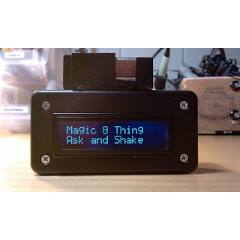
Posted March 2, 2015 by Chris
"…when, with no humans in earshot to ask, I figured I would build a Magic 8 Thing and ask it if I could procrastinate any longer. Was this a lack of motivation to repair a cellphone charger or was it motivation to make a Magic 8 Thing. Irrelevant really as I got both things done in about 10 hours this weekend."
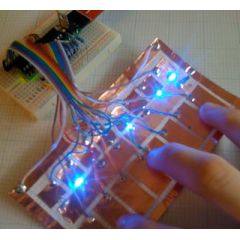
Posted March 1, 2015 by Chris
"Capacitive sensor is a technology sensing proximity position based on capacitive coupling. There are many different methods for producing a capacitive sensor. A simple one way to form an on-off output is by using two layers and a spacer in between. Through a voltage to conductive objects causes positive and negative charges to collect on each object."
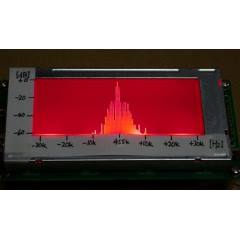
Posted February 25, 2015 by Chris
"This is an experimental work to monitor a spectrum pattern in radio band, and is a continuous project from Audio Spectrum Monitor. To analyze the spectrum of an input signal, I chose an Atmel AVR microcontroller that used in the Audio Spectrum Monitor to process FFT."

Posted February 23, 2015 by Chris
"I needed small ultrasonic sensors for a flying sensor. So I got the smallest one – SRF01. Quite nice unit, works down to 0 cm. There were some problems with it – Maximum detection frequency is only ~14 Hz and the resolution isn’t so great (1 cm). Also, on some occasions after falling from a high height the transducers broke and sensor would only give out constant distance reading. To fix the broken sensors (which I had many) and to satisfy my curiosity I took one apart and reverse engineered it."

Posted February 7, 2015 by Chris
"This small board provides an easy way to record sound and transmit data to the mainboard’s microcontroller. Recording is done using an electret microphone, amplified with a LM386 sound amp. op. Output can directly be wired to the analog-to-digital (ADC) pin of the microcontroller."
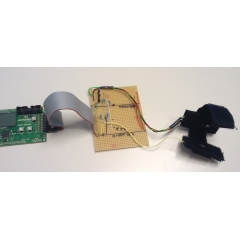
Posted January 27, 2015 by Chris
"The theory behind a pulse oximeter is based around a simple principle: Shine red light and an infrared light through a blood-rich part of the body and measure the difference in absorbed light with a photo sensor. Hemoglobin absorbs red and infrared light differently depending on the oxygen saturation level. Based on this, it is possible to calculate the ratio of oxygenated vs. de-oxygenated hemoglobin."
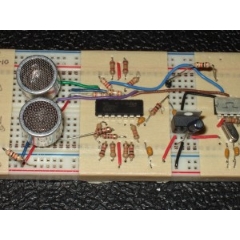
Posted January 21, 2015 by Chris
"The receiver circuit completes the modem’s hardware design. It is simply a two-stage amplifier that gives a total gain of about 2000, in series with a band-pass filter….The goal is for the receiver to output a signal that is around -10 V when idle and peaks at -5 V when it receives a signal. These voltages correspond respectively to logic low and high on the microcontroller."
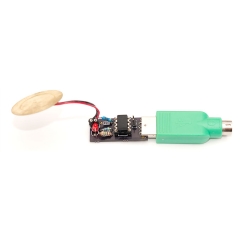
Posted January 20, 2015 by Chris
"Today’s post is something I’ve prepared for a long time. Hardware-wise it’s a simple thing – ATtiny45 emulating a PS/2 device, sending a key press when three knocks are detected in the attached piezoelectric sensor."






